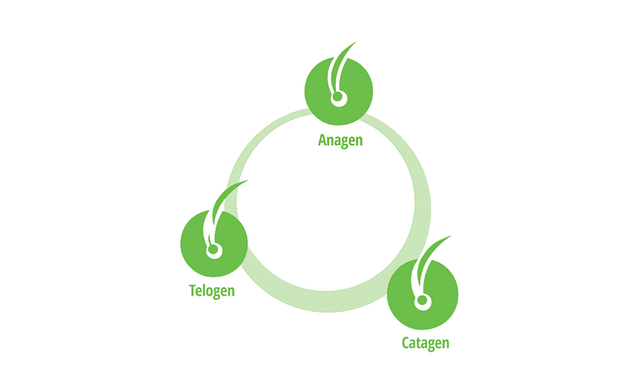Understanding The Hair Growth Cycle
Healthy hair growth begins in the follicles, which are living sacs of skin tissue in the surface of your scalp out of which hair starts to grow in groupings of 1 to 4 hairs. For 2-8 years at a time, your follicles are working continuously, growing hair and pushing it up and through your scalp at a growth rate of about a half-inch per month. Eventually, each follicle enters a resting stage and its hair stops growing. Finally, the hair is shed from the follicle, allowing a new one to spring up in its place and start the cycle all over again.
The Anatomy Of Hair
The portion of the hair that we can see is called the shaft. Each shaft of hair protrudes from its follicle, which is a tube-like pouch just below the surface of the skin. The hair is attached to the base of the follicle by the papilla, or hair root, which is where the hair actually grows and is nourished by blood capillaries. As the hair grows, sebaceous, or oil, glands lubricate and add shine it.
Like the rest of the body, hair is made of cells. New cells form at the root and the hair is gradually pushed further and further out of the follicle. Cells at the base of each hair are close to the blood capillaries and are still living. As they get pushed further away from the base of the follicle, they no longer have any nourishment. As a result, they die and are transformed into a hard protein called keratin, the same material that makes up your fingernails and toenails.
In short, each hair we see above the skin is basically dead protein. It is the follicle, which lies in the skin that is the essential living and growing part of the hair.
The Lifecycle Of Normal Hair Growth
Normal hair follows a continuously repeating cycle of growth: shedding, resting, and regrowth. Since all of these phases are happening at the same time, three strands of hair in the same area of your head might each be in a different growth phase. Each phase has specific characteristics that determine the length of the hair:
- Anagen (growth phase): At this stage, hair grows about half an inch per month. This phase usually lasts between 2 and 8 years.
- Catagen (transitional phase): A short transition period (2-4 weeks) when the base of the root, or bulb, detaches from the blood supply and the hair shaft is pushed up.
- Telogen (resting phase): Hair growth stops temporarily during this resting stage, which can last up to five months. The hair is shed at the end of this period. If the follicle is healthy, a new shaft begins to grow and the cycle begins again.
At any given time, 85% to 90% of your hair is in the first of these phases, actively growing. The remaining 10% to 15% is transitioning or resting in the other two phases. If a follicle is destroyed for any reason, no new hair will grow from it. A normal, healthy head of hair has approximately 100,000 hairs growing.
Problems Affecting Hair Growth
There are numerous factors and conditions that can affect hair growth, but by far the most common culprit of hair thinning is Androgenic Alopecia (Male Pattern Baldness ), a hereditary form of hair loss. Those with this condition inherit hair follicles that are sensitive to hormonal buildup known as dihydrotestosterone (DHT). Hair loss results from the progressive miniaturization of these hair follicles, which leads to shorter and finer hair at the end of each cycle of hair growth.
More specifically, baldness occurs when testosterone combines with an enzyme known as Alpha reductase, which transforms testosterone to DHT. DHT attacks and shrinks the papilla and in time the hair suffocates and the anagen phase of the lifecycle gradually becomes shorter and shorter. Eventually these follicles stop producing hair altogether. Hair loss in women occurs in the same way or due to a variety of other hair loss causes.
Reviving The Hair Cycle
If you are suffering from hair loss, there is a hair loss treatment that will work for you, satisfaction guaranteed. FDA-cleared LaserComb technology and the FDA-approved medication minoxidil (a regrowth agent included in Hair Club’s EXT® Extreme Hair Therapy System ) can slow and reverse hair thinning by clearing DHT out of your system, leaving your hair free to grow thicker and more naturally again.
Hair transplantation surgery works by placing healthy follicles that are more resistant to DHT from the back and sides of the head into thinning or balding areas. Nourished by the scalp’s rich system of capillaries, the follicles take root and re-start the hair cycle, beginning with the telogen phase.


